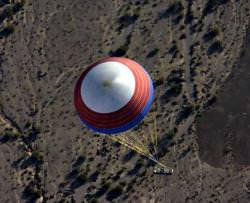This has been an exciting week for NASA's Constellation program -- the missions that will bring humans back to the Moon. Earlier in the week, NASA announced plans for testing abort systems and inflatable Moon habitats.
But on Thursday, November 15 actual tests were conducted for some of the genuine hardware that will be used for the Ares launch vehicles.
Near Yuma, Arizona, engineers tested the parachutes that will bring boosters from the first stage of the massive Ares rockets back to Earth.
Certainly, parachutes and rocket booster recovery is nothing new for NASA. But this new parachute is a whopper. Spanning 150 feet across and weighing 2,000 pounds makes this the largest chute of its kind ever tested for parachutes that will carry some of the heaviest payloads ever delivered.
And the new parachute worked perfectly -- if not patriotically -- with its red, white and blue striped canopy. Made of Kevlar, which is stronger and lighter than the nylon chutes used for the space shuttle's solid rocket booster recovery, these bigger and stronger parachutes can still fit into the same size canister used for the shuttle boosters but yet be lighter.
Although the Ares boosters will actually come down in the Atlantic Ocean, the tests were conducted in the desert near the U.S. Army's Yuma Proving Ground. Additionally, the tests used only a 42,000 pound weighted tub as opposed to the 200,000 pound weight of the actual boosters. But the drop tests from 16,000 ft. from a C-17 airplane simulated the peak loads at parachute opening and measured the drag area to validate the design.
The parachute system will allow the Ares I and Ares V boosters to be recovered and then refurbished and reused for future flights. Ares I will launch the Orion vehicle, which will carry humans to the moon, while the larger Ares V will be used for the Cargo Launch Vehicle.
The boosters are scheduled to be flight tested in 2009.
Keep those tests coming!
Original News Source:
NASA Press Release
 Universe Today
Universe Today
